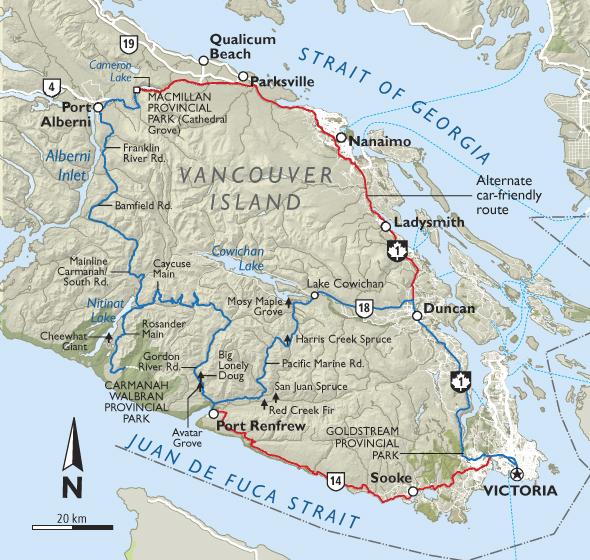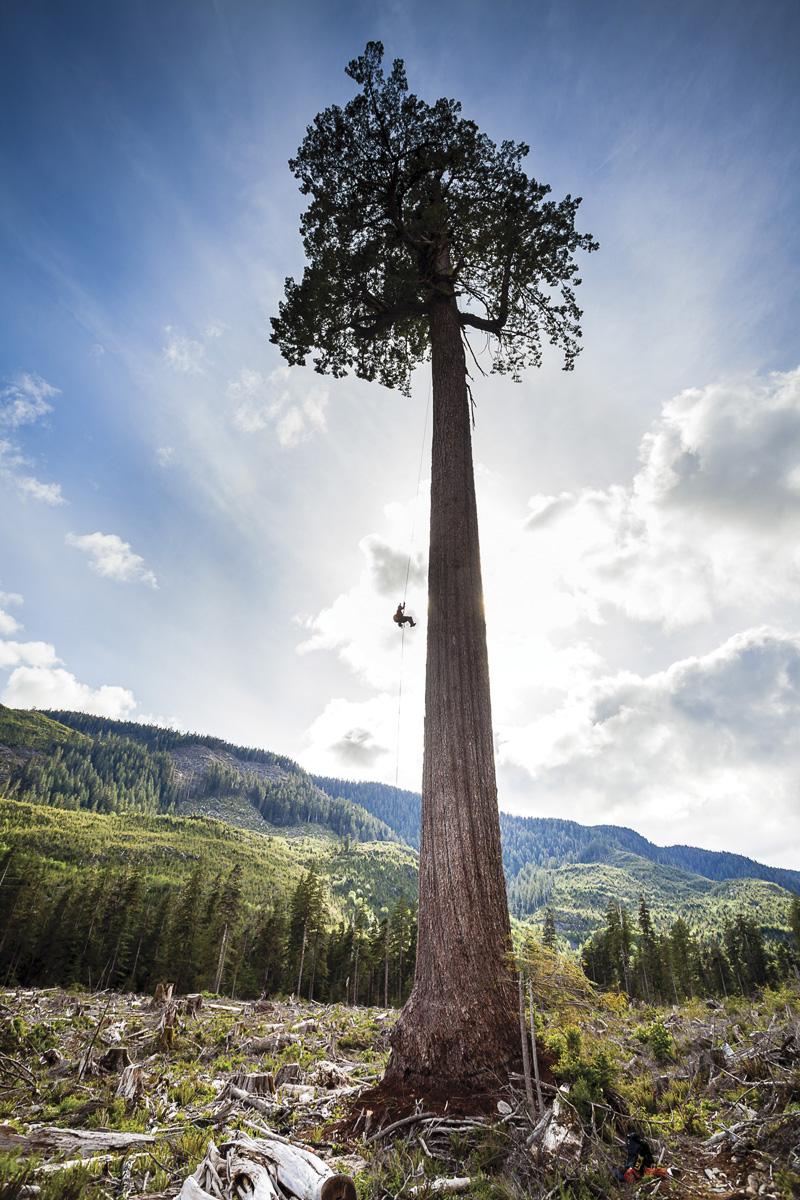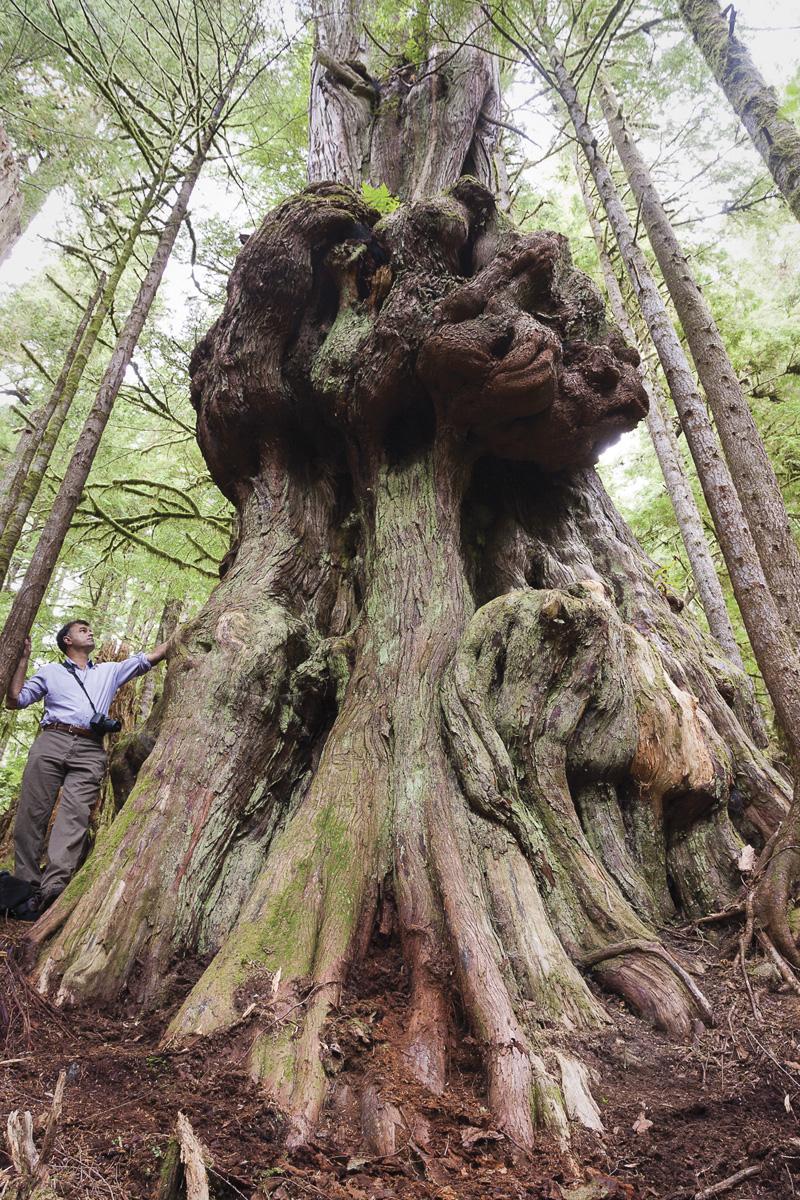BC is home to some of the largest, oldest and most impressive trees in the world, but many of them are not yet protected. Head off the beaten path for this adventurous road trip through Vancouver Island’s ancient forests.
The trip
Most people know about the magnificent trees of Cathedral Grove, and for good reason. It ranks up there with Redwood National Park as one of the most famous old growth forests in the world. However, there are plenty of other smaller but no less impressive ancient groves scattered all over Vancouver Island. Though some of the biggest and oldest trees on the planet exist in our backyard, many are unprotected and could someday be logged, making it all the more important to plan a road trip, go the extra mile and see these giants in person. Awe-inspiring and humbling, there are few experiences like it, and less than 10 per cent of these classic giants remain. So grab a spare tire, head off the beaten path and go hug a tree. They need it. And so do we.

We’re not going to sugarcoat it—it’s a bumpy road ahead. You could easily stay on main highways and see impressive forests. But if you have the means to do so and want a jaw dropping experience, take the backroads. Many routes are rough and a little harder to access, but the encounter is that much more special.
Ideally, having a vehicle with good ground-clearance will be the most comfortable, but don’t let that detail stop you. Cars can make the trek, just go slow, be cautious and make sure to bring a spare tire.
Starting from Victoria, on the south end of Vancouver Island, head north on Highway 19 to Goldstream Provincial Park, just outside of the city. Walking trails in this protected area lead into an ancient world of 600-year-old Douglas firs and western red cedars as well as numerous other species including western yew and hemlock, red alder, big leaf maple, black cottonwood and arbutus, which is exclusively found in southwest coast of B.C. and the Pacific Northwest. Waterfalls, creeks, wildflowers and hiking trails make this a popular destination and an easy escape from the provincial capital into a wild wonderland.
Stay north on the Island Highway, turn west on Highway 18 and take the Lake Cowichan turnoff. Head through town along South Shore Road and drive roughly 15 minutes to Honeymoon Bay. Near the Honeymoon Bay Ecological Reserve, you will find what the Ancient Tree Alliance calls “Canada’s Mossiest Rainforest,” an enchanting woodland filled with old-growth big leaf maple. Here, you can walk through curtains of bright green moss and massive ferns draping over enormous trees, some measuring as wide as 2.5 metres in diameter. Unlike most old growth forests on the island, this one is made of deciduous, broadleaf trees and is nicknamed Fangorn Forest after the famous woods in J.R.R Tolkien’s Lord of the Rings. The trees here are currently unprotected, set on a mix of private and crown land, and are in the traditional territory of the Cowichan people, who are part of the Hul’quami’num First Nations.
Head back toward Lake Cowichan and take a right turn onto the slow and winding Pacific Marine Road, also known as the Pacific Rim Circle Route, to Port Renfrew. This area has the biggest concentration of record-sized trees in Canada. Along this drive, if time and means allow, you’ll discover some of the largest trees in Canada (see sidebar). Whether you explore the logging roads or stay on course, make your way to Avatar Grove.
Thanks to the committed individuals and the Ancient Forest Alliance, this magnificent forest is now protected and is the second-most popular grove in B.C. A small sign at the trailhead leads the way into centuries-old cedars, fir and some of the weirdest looking trees around. These big guys feature giant burrows and massive lumps including those on Canada’s gnarliest cedar, which features with a four-metre long burrow. With the help of the alliance and passionate donors, a boardwalk has recently been built to allow better accessibility and to broaden awareness.
Not for the faint of heart, a twisting, three-hour drive from Port Renfrew will lead you to Walbran valley, home to Castle Grove, also known as heaven on Earth. A utopia of majestic forestland, this area offers natural swimming pools, the Seven Steps to Heaven waterfall, interesting rock formations and is home to various species of birds and wildlife. It’s also home to the grandest growth of ancient cedars anywhere, including the legendary Castle Giant, measuring five metres at the base and an estimated 1,200 years old. Sadly, the area is endangered and heavily threatened with logging.
Just north is the famous Carmanah Valley, which received widespread media coverage in the 1990s, when protesters stepped in to save the forest from large-scale logging. This valley is known as ground zero in the ancient forest movement and is now protected. It’s the grandest ancient forest in the country.
For the committed, the journey can continue through backroads to Port Alberni before turning to Highways 4 and 19 to the iconic Cathedral Grove in MacMillan Provincial Park. (A slightly longer but more straightforward route would be to double back through Lake Cowichan on Highway 18, then head north through Nanaimo via Highway 19.) Cathedral Grove is a coveted tourist hot spot. With easy access right off the highway, it’s a popular pit stop for locals and travellers on their way to Port Alberni and Tofino. While the park itself is protected, few are aware that Mount Horne right behind it is under threat. It’s a natural extension of Cathedral Grove and another grand forest all its own, but should it not receive recognition and protection could be lost to industry like so many forests before.
The giants
Following the Pacific Rim Circle Route Road from Highway 18, around 35 kilometres from Lake Cowichan, the Harris Creek Spruce (73.5 metres high and 12.6 metres in circumference at the base) is the most easily accessed giant on the route—a boardwalk will lead you right to it.
Next up is the San Juan Spruce (62.5 metres high, 12 metres in circumference), which is Canada’s largest sitka spruce, based on volume. It can be found about five kilometres up Len’s Creek Main Road (at 9 Mile Junction off the Pacific Rim Circle Route Road) at a forest service campground. This is a semi-rough road to drive, but it’s a great spot to picnic, explore and even pitch a tent if so inclined.
Going deeper into the forest, as the road gets progressively rougher, is the Red Creek Fir (73.8 metres high, 13.3 metres in circumference)—the Largest Douglas fir on the planet. This tree is estimated to be about 750 to 1,000 years old.
Big Lonely Doug (66 metres high, 12 metres in circumference) is the second-largest Douglas fir in Canada, and was just discovered in a clear cut last year. Presumably, a sympathetic logger let it be while cutting down all the other giants around it. Although Big Lonely Doug’s lifeline was spared, exposure means it is under threat from erosion and strong winds.

The Cheewhat Giant (56 metres high, 18.8 metres in circumference), a western red cedar in Pacific Rim National Park Reserve, is the largest tree in Canada. Several hours north from Lake Cowichan on challenging logging roads, access is difficult but the reward is tremendous.
Travel information
Distance: The Pacific Rim Circle Route is 255 kilometres long, plus more for detours.
Duration: Avatar Grove and the trees along the Pacific Rim Circle Route can be seen a long day trip from Victoria, but two or three days will allow for more exploration. The trip to see Cathedral Grove or the Cheewhat Giant will require an additional day or two of travel.
Resources: ancientforestalliance.org; pacificmarinecircleroute.com.
Travel Tip: Many of the trees mentioned here are found along old logging roads with no cell coverage, so make sure someone knows where you are going and you have a full tank of gas, a spare tire and a high-clearance vehicle.


